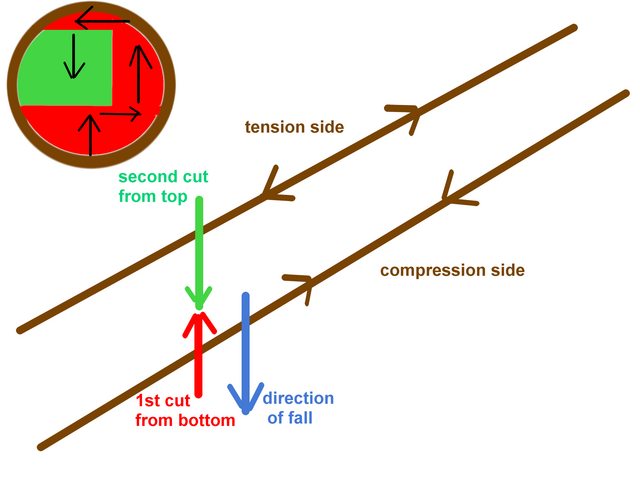AussieSawyer
ArboristSite Lurker
Hello everyone,
New to saw ownership and to the forum. At the end of the third day with my new saw (455 Husqvarna, already good friends with this machine, having run 5 tanks of fuel so far), I undertook one of my larger tree cutting endeavours - and shouldn't have (tired at that point, after 6 pm). I knew before getting underway that the tree would hang up - it's the only one in the area that I wanted brought down. Once it was laid over, I decided to start sectioning. I could see which side of the trunk was under tension (underside), but for some reason (new habit?) I still moved to the underside to complete the cut - jamming in the process.
Although I managed to separate at that point with 2 wedges, everything went straight to the ground, now pinning the lower part of the chain under the corner of the trunk. The only way out of that was to beat laterally on the trunk with a sledgehammer, and coerce the wife to ease the saw out!
Questions for the pros
1. When cutting for this type of landing, how should I have modified my initial cuts at base? (I see that my scarf was undersized, even for a clear fall). Should I have separated the trunk from it's base before going anything else (it was still attached with hinge wood as I went for the 2nd cut).
2. What is the next action after the fallen tree has settled against others? Was I more or less doing the right thing?
I know that in this case, had I stayed on the top side of that second cut, the saw probably would have just gone clear through. But I also need to learn about known dangers inherent in that type of airborne (suspended trunk) cut. This might have been a good time to put in several parallel cuts, to more carefully see how the tension was playing out.
As I move to each tree, I am clearing out local areas around the base, clearing and mapping out escape routes, etc. (establishing good practices as I go).
Tomorrow, I clean off the bar and chain and find out if either needs to be replaced! (oh, and retrieve wedges that I drove into the soil in a futile attempt to ease the trunk away from the chain - it doesn't work).
Your comments will be appreciated.
Grant.
New to saw ownership and to the forum. At the end of the third day with my new saw (455 Husqvarna, already good friends with this machine, having run 5 tanks of fuel so far), I undertook one of my larger tree cutting endeavours - and shouldn't have (tired at that point, after 6 pm). I knew before getting underway that the tree would hang up - it's the only one in the area that I wanted brought down. Once it was laid over, I decided to start sectioning. I could see which side of the trunk was under tension (underside), but for some reason (new habit?) I still moved to the underside to complete the cut - jamming in the process.
Although I managed to separate at that point with 2 wedges, everything went straight to the ground, now pinning the lower part of the chain under the corner of the trunk. The only way out of that was to beat laterally on the trunk with a sledgehammer, and coerce the wife to ease the saw out!
Questions for the pros
1. When cutting for this type of landing, how should I have modified my initial cuts at base? (I see that my scarf was undersized, even for a clear fall). Should I have separated the trunk from it's base before going anything else (it was still attached with hinge wood as I went for the 2nd cut).
2. What is the next action after the fallen tree has settled against others? Was I more or less doing the right thing?
I know that in this case, had I stayed on the top side of that second cut, the saw probably would have just gone clear through. But I also need to learn about known dangers inherent in that type of airborne (suspended trunk) cut. This might have been a good time to put in several parallel cuts, to more carefully see how the tension was playing out.
As I move to each tree, I am clearing out local areas around the base, clearing and mapping out escape routes, etc. (establishing good practices as I go).
Tomorrow, I clean off the bar and chain and find out if either needs to be replaced! (oh, and retrieve wedges that I drove into the soil in a futile attempt to ease the trunk away from the chain - it doesn't work).
Your comments will be appreciated.
Grant.










